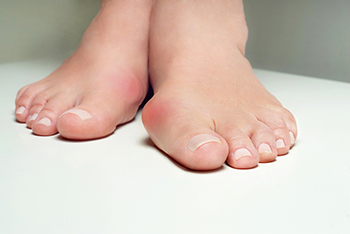
Bunions affect many people around the globe. They are considered to be a deformity, and can develop from wearing shoes that do not have adequate room in the toe area. Additionally, people who rarely stretch, receive massages, or exercise their feet may be prone to developing a bunion. Many family members may get bunions, and this can come from genetic factors. They appear as a bony protrusion that forms on the side of the big toe and can cause the need to purchase larger shoes. Large bunions can produce pain and discomfort, and mild relief may be found when specific exercises are performed. An effective stretch for the toes consists of rolling a tennis ball on the sole of the foot underneath the toes. This may help to release existing muscle tension. The toes can increase mobility by gripping the foot between the toes with the hands and moving the toes back and forth. If you have this ailment, and would like additional information about how to treat bunions, please contact a podiatrist who can offer you correct treatment techniques.
If you are suffering from bunion pain, contact Howard Kimmel, DPM of Buckeye Foot Care. Our doctor can provide the care you need to keep you pain-free and on your feet.
What Is a Bunion?
Bunions are painful bony bumps that usually develop on the inside of the foot at the joint of the big toe. As the deformity increases over time, it may become painful to walk and wear shoes. Women are more likely to exacerbate existing bunions since they often wear tight, narrow shoes that shift their toes together. Bunion pain can be relieved by wearing wider shoes with enough room for the toes.
Causes
- Genetics – some people inherit feet that are more prone to bunion development
- Inflammatory Conditions - rheumatoid arthritis and polio may cause bunion development
Symptoms
- Redness and inflammation
- Pain and tenderness
- Callus or corns on the bump
- Restricted motion in the big toe
In order to diagnose your bunion, your podiatrist may ask about your medical history, symptoms, and general health. Your doctor might also order an x-ray to take a closer look at your feet. Nonsurgical treatment options include orthotics, padding, icing, changes in footwear, and medication. If nonsurgical treatments don’t alleviate your bunion pain, surgery may be necessary.
If you have any questions, please feel free to contact one of our offices located in Brook Park and Willoughby, OH . We offer the newest diagnostic and treatment technologies for all your foot care needs.
